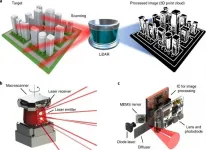(Press-News.org) A randomized double-blind controlled trial of convalescent plasma for adults hospitalized with severe COVID-19 found that mortality at 28 days in the treatment arm was half the rate seen in the control arm (12.6% vs. 24.6%), although treatment was not associated with other improvements in clinical status.
The study was led by investigators from the Center for Infection and Immunity at Columbia University Mailman School of Public Health; Columbia University Irving Medical Center; ICAP at Columbia University; Instituto Nacional de Infectologia and Hospital Federal dos Servidores do Estado in Rio de Janeiro, Brazil; University of Washington; and New York Blood Center. The results are published in the Journal of Clinical Investigation.
According to the investigators, one possible explanation for the discrepancy between lack of clinical improvement and improved survival is that severely ill Covid-19 patients survived but remained hospitalized at their baseline status. The study also reports trends towards improved clinical status among patients who received convalescent plasma less than seven days after symptom onset and those who received convalescent plasma with higher-titers of neutralizing antibody and concomitant corticosteroids.
The investigators conducted this randomized, double-blind, placebo-controlled trial among adults hospitalized with severe and critical COVID-19 at 5 sites, including 73 patients enrolled in New York City and 150 enrolled in Rio de Janeiro. Patients were randomized in a 2:1 ratio to receive a single transfusion of either convalescent plasma or normal control plasma.
The median age of participants was 61 years and two-thirds of them were male. In a subset of nasopharyngeal swab samples from Brazil that underwent viral genomic sequencing, no evidence of neutralization-escape mutants was detected.
"We should not close the door prematurely on research into the therapeutic value of convalescent plasma research for severe COVID-19, particularly in the context of emerging viral variants in low- and middle-income countries," says first and corresponding author Max R. O'Donnell, MD, associate professor of medicine and epidemiology, and member of the Center for Infection and Immunity at Columbia Irving Medical Center. "Locally donated convalescent plasma has the potential to be highly responsive to local viral ecology and sustainable, since many countries already have the infrastructure needed to collect and transfuse donated plasma."
"This is the first clinical trial sponsored by the Global Alliance for Preventing Pandemics. It illustrates the role of international collaborations in responding to emerging infectious diseases," says W. Ian Lipkin, MD, director of the Center for Infection and Immunity and John Snow Professor of Epidemiology at Columbia University Mailman School of Public Health.
PAST RESEARCH ON CONVALESCENT PLASMA
Observational studies have suggested possible clinical efficacy and safety using convalescent plasma, primarily among patients who were not receiving invasive mechanical ventilation and those with shorter durations of illness. Despite these signals, data from randomized controlled trials supporting the use of convalescent plasma in hospitalized COVID-19 patients are limited. Open-label trials, including the large Randomized Evaluation of COVID-19 Therapy (RECOVERY) trial, reported no significant improvements in clinical outcomes among patients hospitalized with severe COVID-19. A double-blind, placebo-controlled trial in Argentina also reported no improvement in clinical outcomes using the therapy with the same type of patients. Another Columbia-led is underway in Brazil to test the effectiveness of convalescent plasma in patients who have less severe disease.
POTENTIAL ADVANTAGES OF CONVALESCENT PLASMA
Convalescent plasma may be donated and transfused locally, therefore its use may be more adaptable to a rapidly changing mix of SARS-CoV-2 variants than other interventions. In contrast, monoclonal antibody therapies may need to be repeatedly engineered and combined to optimize potency among emergent variants. Further, since the collection and distribution of convalescent plasma can be performed using existing blood donation protocols and infrastructure, the therapy may be more scalable for use in low- and middle-income countries.
INFORMATION:
A full list of co-authors is available online. Max R. O'Donnell and Matthew J. Cummings at Columbia participated as investigators for clinical trials evaluating the efficacy and safety of remdesivir in hospitalized patients with COVID-19, sponsored by Gilead Sciences. All compensation for this work was paid to Columbia University. Vinay Gupta at the Institute for Health Metrics and Evaluation, University of Washington, is employed by Amazon Care. The remaining authors declare no interests relevant to the submitted work.
The research was supported by funding from the Amazon Foundation and Skoll Foundation.
Patients with heart failure with preserved ejection fraction who took the antifibrotic drug pirfenidone saw a significant reduction in a marker of heart muscle scarring compared with patients who received a placebo, based on findings from an early-phase trial presented at the American College of Cardiology's 70th Annual Scientific Session.
"Observational data suggests that heart muscle scarring, or fibrosis, is an important disease process for heart failure prognosis," said Chris Miller, MD, a cardiologist and National Institute for Health Research Clinician Scientist at the University ...
Patients with heart failure with reduced ejection fraction (HFrEF) did not have better health outcomes if they took sacubitril/valsartan combination therapy compared with valsartan alone, according to new data presented at the American College of Cardiology's 70th Annual Scientific Session.
Heart failure, a leading cause of hospitalization among adults over age 65, is a condition in which the heart becomes too weak to pump blood effectively to the rest of the body, causing fatigue and shortness of breath. For patients with severe heart failure, treatment options are limited to a mechanical heart pump or heart transplant. Doctors have sought ways to slow the progression of severe heart failure ...
The likelihood of people surviving COVID-19 in UK hospitals has been improving over time, a new study has found.
Research published in The Lancet Respiratory Medicine by the ISARIC Coronavirus Clinical Characterisation Consortium found that in-hospital mortality declined from 32% at the start of the first wave (Mar-Apr 2020) to 16% at the end of the first wave (Jun-Jul 2020).
In their study of 63,972 adults admitted to 247 UK hospitals the researchers found reductions in mortality were observed in all age groups, in all ethnic groups, for both sexes, and in patients with and without comorbidities. This improvement was ...
A group of Brazilian and Portuguese researchers observed a correlation between the presence of lead in the organism and a microRNA (miRNA) that could be associated with the mechanisms that regulate DNA methylation, a physiological process required to control gene expression and ensure that genes function properly.
The alterations were detected in blood cells from workers in automotive battery plants, which use lead as a raw material. Curiously, lead levels in blood samples from 85 volunteers – averaging 20 micrograms per deciliter of blood (20 μg/dl) – were lower than the acceptable ceiling defined in Brazilian law (60 μg/dl).
The study was supported by FAPESP and ...
A long noncoding RNA whose function was previously unknown turns out to play an important role in promoting the body's immune response against cancer and holds promise for enhancing the efficacy of anti-cancer immunotherapy.
That's according to new findings reported in Nature Cell Biology by researchers at the University of Michigan Rogel Cancer Center.
The group dubbed the RNA they identified LIMIT -- for long noncoding RNA inducing major histocompatibility complex class I and immunogenicity of tumor.
"LIMIT is easy to remember, but really it does the opposite. It stimulates immune functions against cancer," says senior study author Weiping Zou, M.D., Ph.D., the Charles B. de Nancrede Professor of Pathology, Immunology, Biology, and Surgery at U-M.
Only a small part of the human ...
Researchers at the University of California, Davis, have found a link between traffic-related air pollution and an increased risk for age-related dementia, including Alzheimer's disease. Their study, based on rodent models, corroborates previous epidemiological evidence showing this association.
Alzheimer's disease is the most common cause of age-related dementia and the sixth leading cause of death in the United States. More than 5 million Americans currently live with Alzheimer's disease -- a number that is expected to triple by 2050 as the population ages. ...
In patients receiving therapeutic hypothermia after suffering out-of-hospital cardiac arrest, those who were cooled below 31 degrees Celsius (about 88 degrees Fahrenheit) for 24 hours showed no difference in terms of death or poor neurological outcomes at six months compared with patients receiving guideline-recommended cooling of 34 C (about 93 F). These findings are part of a study presented at the American College of Cardiology's 70th Annual Scientific Session.
Therapeutic hypothermia is a procedure in which a person's body is cooled far below normal body temperature. It has been shown to improve survival and reduce brain damage in people who have been resuscitated but remain comatose after suffering cardiac arrest (when the heart stops ...
Sperm are generally viewed as having just one action in reproduction - to fertilise the female's egg - but studies at the University of Adelaide are overturning that view.
Published in Nature Research journal Communications Biology, new research shows that sperm also deliver signals directly to the female reproductive tissues to increase the chances of conception.
Robinson Research Institute's Professor Sarah Robertson, who led the project, said: "This research is the first to show that the female immune response is persuaded by signals in sperm to allow the male partner ...
Marilyn Monroe famously sang that diamonds are a girl's best friend, but they are also very popular with quantum scientists - with two new research breakthroughs poised to accelerate the development of synthetic diamond-based quantum technology, improve scalability, and dramatically reduce manufacturing costs.
While silicon is traditionally used for computer and mobile phone hardware, diamond has unique properties that make it particularly useful as a base for emerging quantum technologies such as quantum supercomputers, secure communications and sensors.
However there are two key problems; cost, and difficulty in fabricating the single crystal diamond layer, which is smaller ...
The nanophotonics-based LiDAR technology developed by a POSTECH research team was presented as an invited paper in Nature Nanotechnology, the leading academic journal in the field of nanoscience and nanoengineering.
In this paper, a POSTECH research team (led by Professor Junsuk Rho of the departments of mechanical engineering and chemical engineering, postdoctoral researcher Dr. Inki Kim of the Department of Mechanical Engineering, and Ph.D. candidate Jaehyuck Jang of the Department of Chemical Engineering) in cooperation with the French National Science Institute (CNRS-CRHEA) focused on the LiDAR device developed through studying the metamaterials based ultralight nanophotonics.
In addition, the paper ...


